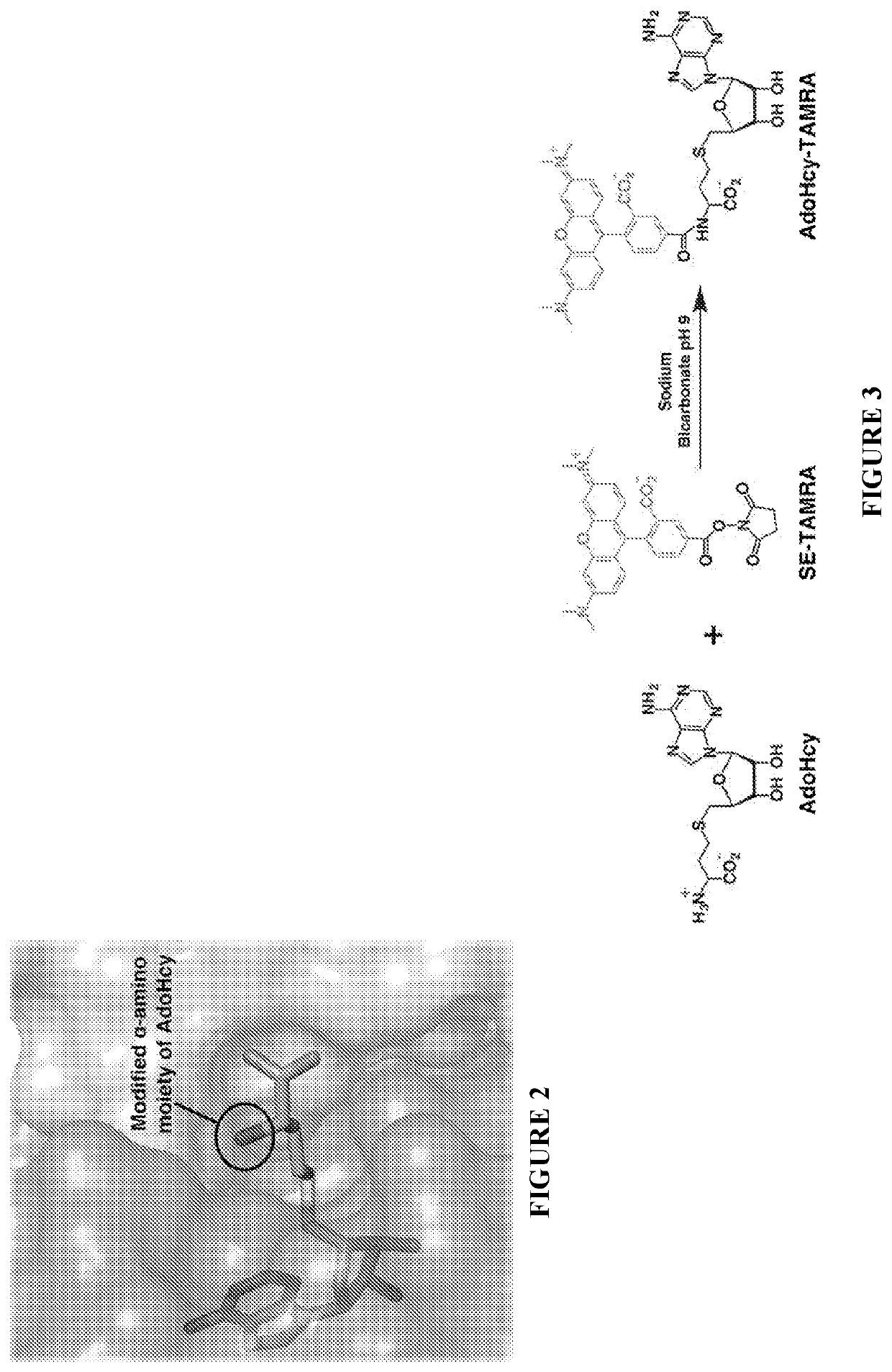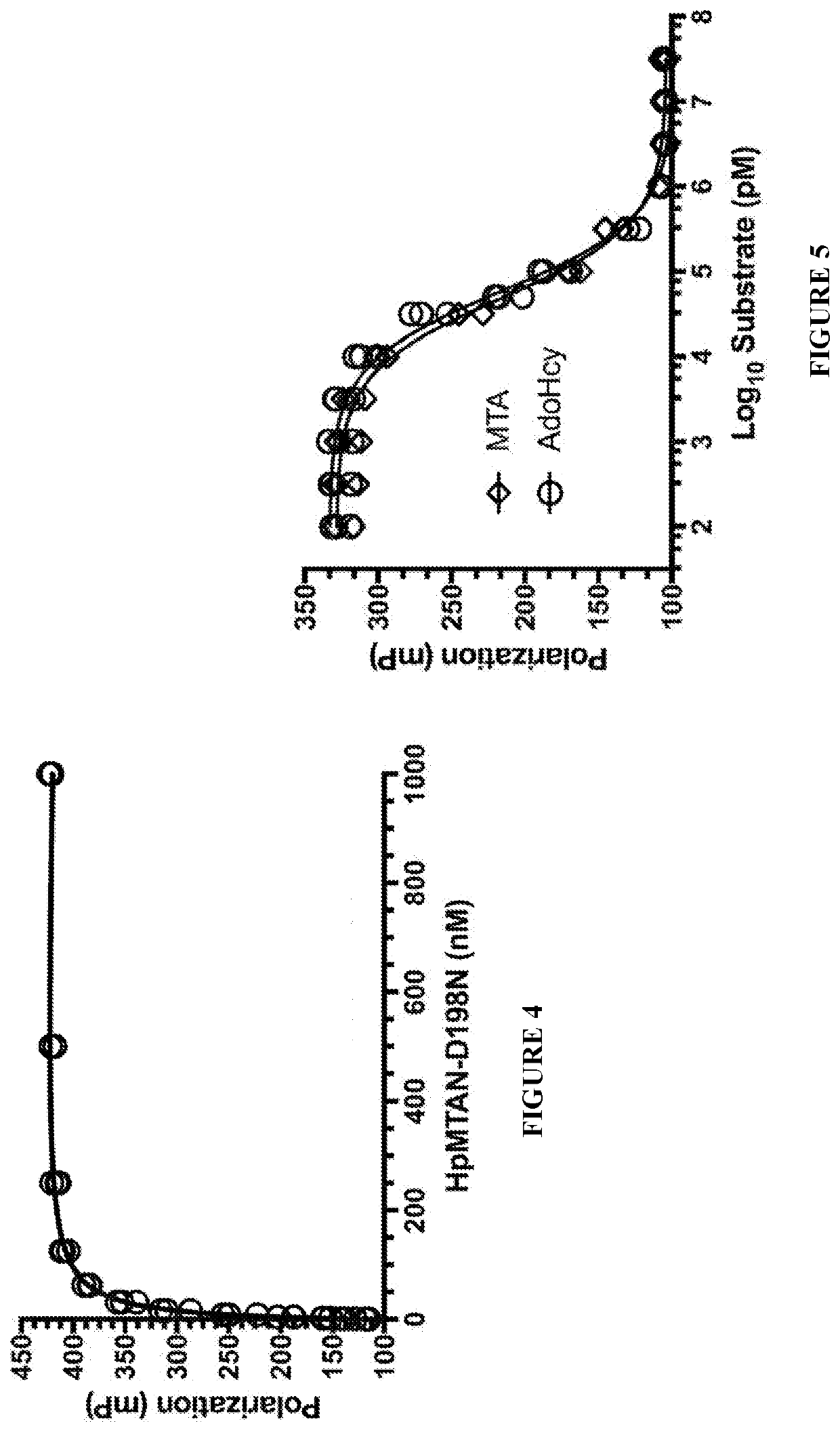Methods and kits for quantifying adenosine-containing molecules
a technology of adenosine and adenosine, which is applied in the field of biochemical assays for quantifying adenosine and adenosinecontaining compounds, can solve the problems of inability to detect mtases in time, and inability to achieve high-throughput screening. high-throughput screening, and the early-developed spectroscopic kinetic methods of mtases
- Summary
- Abstract
- Description
- Claims
- Application Information
AI Technical Summary
Benefits of technology
Problems solved by technology
Method used
Image
Examples
example 1
of D198N-MTAN
[0125]Site directed mutagenesis was performed on a pET-32 plasmid containing the pfs gene to create the HpMTAN variant (SEQ ID NO: 2). After confirming the presence of the D198N mutation, the pET-32 HpMTAN variant plasmid was used to transform BL21 (DE3) Rosetta cells. The newly transformed Rosetta cells were grown in LB media containing 0.1 mM chloramphenicol and 0.3 mM ampicillin at 37° C. Once the cell culture reached an OD600 of 0.6-0.8, the temperature was decreased to 16° C. followed by the addition of 0.1 mM IPTG and incubated overnight. The cells were pelleted and resuspended in a 5 mM β-mercaptoethanol, 5 mM imidazole, 500 mM NaCl and 100 mM HEPES pH 7.5 buffer. The resuspended cells were lysed with DNase and Lysozyme on ice followed by sonication. The bacterial lysate was centrifuged at 15,000×g, and the supernatant was applied to a 5 mL HiTrap TALON Crude column. The column containing HpMTAN-D198N was washed with a buffer identical to the resuspension buffer,...
example 2
of the AdoHcy-TAMRA Fluorescent Probe
[0126]One-pot synthesis of the fluorescent probe was performed by combining AdoHcy (1.3 mg, Sigma) in a 100-mM sodium bicarbonate buffer at pH 9 with 5-carboxytetramethylrhodamine succinimidyl ester (SE-TAMRA, 1.0 mg, Setareh Biotech) in 100% DMSO (FIG. 3). The reaction was incubated overnight at room temperature protected from light to avoid photobleaching of the fluorophore. The resulting product was purified by reverse-phase HPLC (Waters 2487) using a linear gradient consisting of 0.1% trifluoroacetic acid and acetonitrile on an analytical C18 column. Elution of AdoHcy-TAMRA and AdoHcy were monitored spectroscopically at the absorption maximum of the fluorophore (545 nm) and the adenine moiety of AdoHcy (260 nm) using a dual wavelength detector (Waters 2487 Dual λ Absorbance Detector). Eluted compounds demonstrating absorption at both wavelengths were collected and further characterized using ESI-MS (Finnigan LC-Q-Deca) in positive ion mode. T...
example 3
um Binding Studies Between MTAN-D198N and AdoHcy-TAMRA
[0127]All FP assays used to conduct equilibrium binding studies between MTAN-D198N and AdoHcy-TAMRA were performed using a Biotek Synergy H4 Hybrid Reader to measure the parallel (F∥) and perpendicular (F⊥) fluorescence intensities, which were then used to calculate the mP value according to Equation 1, below.
mP=1000×(F-F⊥)(F+F⊥)(Equation1)
MTAN-D198N and AdoHcy-TAMRA were synthesized according to the procedures in Example 1 and Example 2, respectively. The protein-probe complex for performing the equilibrium binding FP experiments between MTAN-D198N and AdoHcy-TAMRA were incubated for 10 minutes at ambient temperature prior to measuring the fluorescence intensities. Equilibrium binding experiments to determine the Kd value for the MTAN-D198N / AdoHcy-TAMRA complex were performed using 5 nM of AdoHcy-TAMRA with varying concentrations of MTAN-D198N in 50 mM HEPES at pH 7.5. The resulting data were fitted to a one site—total binding e...
PUM
| Property | Measurement | Unit |
|---|---|---|
| Mass | aaaaa | aaaaa |
| Mass | aaaaa | aaaaa |
| Mass | aaaaa | aaaaa |
Abstract
Description
Claims
Application Information
 Login to View More
Login to View More - R&D
- Intellectual Property
- Life Sciences
- Materials
- Tech Scout
- Unparalleled Data Quality
- Higher Quality Content
- 60% Fewer Hallucinations
Browse by: Latest US Patents, China's latest patents, Technical Efficacy Thesaurus, Application Domain, Technology Topic, Popular Technical Reports.
© 2025 PatSnap. All rights reserved.Legal|Privacy policy|Modern Slavery Act Transparency Statement|Sitemap|About US| Contact US: help@patsnap.com



